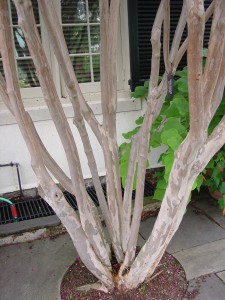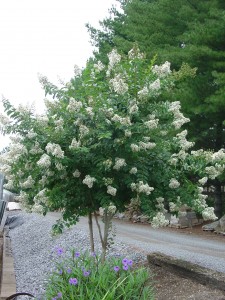Crape myrtles are dependable trees and shrubs in zones 7 – 10. In northern areas of USDA zone 6, a number of crape myrtle varieties (cultivars) are rated as winter hardy perennials but not develop into a full sized woody tree or shrub described on the plant tag. In northeastern U.S. cities such as Philadelphia, Wilmington or Baltimore, crape myrtles are rated as hardy perennials.
In record breaking cold winters main branches and trunks frequently dieback near the ground and need to be cut back near the ground. Dieback may occur 1-2 years every decade. By mid-spring new shoots should vigorously sucker back from the ground. From several new shoots, select 1, 3, or 5 strong shoots to develop a new single or multi-trunk tree or shrub. Fertilize when you see emerging shoots. It will likely bloom on the new shoots by late summer.
In the northeastern U.S. select varieties, some public gardens have found to be hardy. Andrew Bunting, plant curator at the Scott Arboretum (campus of Swarthmore College in Swarthmore, PA) reported the following cultivars survived the frigid winter 2013-4 with virtually no damage:
fauriei ‘Fantasy’ (35 ft. tree form, small white flowers)
fauriei ‘Townhouse’ (30 ft. tree, small white flowers)
indica ‘Carolina Beauty’ (tree form, small deep pink flowers)
indica ‘Pink Velour’ (10 12 ft. shrub, small bright pink)
x ‘Acoma’ (10-12 ft. shrub, large pure white)
x ‘Lipan’ (26-28 ft. tree, large lavender flowers)
x ‘Muskogee’ (26-28 ft. tree, large pink flowers)
x ‘Natchez’ (28-30 ft. tree, large white flowers)
x ‘Osage’ (15-18 ft. tree, large clear pink)
x Tuscarora’ (28-30 ft. tree, large dark pink)
x Tuskegee’ (28 ft. tree, large dark pink)
Many of the hardiest cultivars, now numbering 33 originated from the U.S. National Arboretum breeding program. If you wish to start out with just 3 or 4 varieties, select ‘Natchez’ and ‘Muskogee’ (tree forms) and ‘Acoma’ and ‘Osage’ (shrub forms).
Addendum: For many years Chanticleer Gardens in Wayne, PA has grown ‘Tonto’ in a partially protected area (see photo). 8-10 ft. shrub, red flowers, light tan bark



 Posted in
Posted in 
